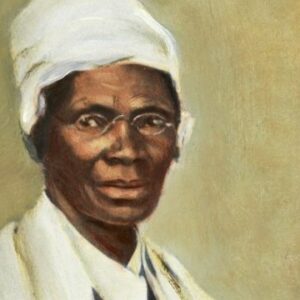Sojourner Truth was an African American abolitionist who made history as the first black woman to successfully prosecute and win a case against a white man in order to reclaim her son who had been sold into slavery unlawfully. She was also a well-known women’s rights activist, well known for her speech “Ain’t I a Woman?” given at the Ohio Women’s Rights Convention. She was born Isabella Baumfree, but when she received a spiritual insight about the purpose of her life, she changed her name to Sojourner Truth and began traveling and speaking about the abolition of slavery. She was born into slavery and later married off to another slave against her will. She had five children, two of whom she was able to save from slavery; her other children, however, were not able to be rescued until they were legally liberated. Later, she became a member of the Northampton Association of Education and Industry in Northampton, Massachusetts, which was created by prominent abolitionists at the time. She met William Lloyd Garrison, Frederick Douglass, and David Ruggles when she was there. She joined abolitionist George Benson when the group collapsed and began visiting conferences with him, giving talks on anti-slavery causes, women’s rights, jail reforms, and other topics. She was a well-respected orator whose work was valued by abolitionists and women’s rights campaigners.
Childhood and Adolescence
She was one of several children born to slaves James Baumfree and Elizabeth, who historians estimate to be between 10 and 12 years old. Colonel Hardenbergh was the owner of her parents.
Truth, together with a flock of sheep, was sold at an auction in 1806 after her owners died. She was nine years old at the time. John Neely, her new owner, was a harsh man.
She was sold a few more times before coming into the possession of John Dumont in 1810. Dumont treated his slaves well, but his wife mistreated them and made their lives difficult.
A Later Years
In the state of New York, work on legislation to abolish slavery began in 1799, though the legal process for emancipating all slaves was not finished until July 1827. In late 1826, Truth escaped to freedom with her infant daughter; she had to leave her other children behind because they could not be legally liberated.
She obtained labor and lived with Isaac and Maria Van Wagener until the New York State Emancipation Act was passed in 1827.
Dumont had unlawfully sold Truth’s five-year-old son Peter after the passage of the statute that emancipated all slaves. She went to retrieve her son, who was being abused by his new owner, as she had learned. She was one of the first black women to win such a case against a white guy after months of protracted judicial proceedings.
She converted to Christianity and relocated to New York City with Peter, where she found work as a housekeeper for Elijah Pierson, a Christian Evangelist, and stayed with him until his death.
In 1843, she had a spiritual experience and took the name ‘Sojourner Truth.’ She began giving talks advocating the abolition of slavery while on the road. In 1844, she became a member of the Northampton Association of Education and Industry, based in Northampton, Massachusetts.
She met prominent people including William Lloyd Garrison, Frederick Douglass, and David Ruggles at the abolitionist-founded organization.
She had no formal education and was unable to read or write. As a result, she dictated her memoirs to Olive Gilbert, a friend. In 1850, abolitionist William Lloyd Garrison secretly released her book, ‘The Narrative of Sojourner Truth: A Northern Slave.’
In 1851, he joined George Thompson, an abolitionist, and orator. She spoke at the Ohio Women’s Rights Convention, giving the renowned speech “Ain’t I a Woman?”
From 1851 to 1853, she collaborated with Marius Robinson, the editor of the ‘Ohio Anti-Slavery Bugle.’ She became a well-known abolitionist speaker and spent the next several years traveling and speaking on issues such as slavery, women’s suffrage, politics, jail reforms, and women’s rights.
In 1867, she gave a speech to the American Equal Rights Association and was named one of the primary convention speakers. She spoke on black women’s rights as well as the problem of women’s suffrage, which she felt was an undervalued female right.
During the Civil War, she fought for the enlistment of black soldiers into the army. By joining the 54th Massachusetts Regiment, her own grandson set an example for others to follow.
Sojourner’s Major Projects
She was a leading feminist figure in the abolitionist movement and a proponent of women’s rights. She was a brave orator who talked passionately about anti-slavery campaigns, women’s emancipation, the capital penalty, jail reforms, and universal property rights, among other themes.
Personal History and Legacy
She fell in love with a slave named Robert who belonged to a different owner when she was a teenager. She even had a child with him despite the fact that they were unable to marry due to Robert’s owner’s prohibition.
Dumont forcibly married her to another slave, Thomas, with whom she had four children, one of whom died as a baby.
She lived an active life, lecturing and campaigning long into her senior years. In 1883, she died of old age-related illnesses.
Estimated Net worth
Sojourner, a $3 million and $5 million earner The majority of Sojourner’s revenue came from her Yeezy footwear.
While she had overstated the size of her business throughout the years, the money she made from it was real enough to make her one of the richest celebrities of all time. Sojourner, Krysten Truth’s primary source of income was as a successful activist.
Trivia
In 2002, the academic Molefi Asante named this abolitionist to his list of the 100 Greatest African Americans.
Her bust was sculpted by acclaimed sculptor Artis Lane and was the first black lady to be honored with a bust in the United States Capitol.


